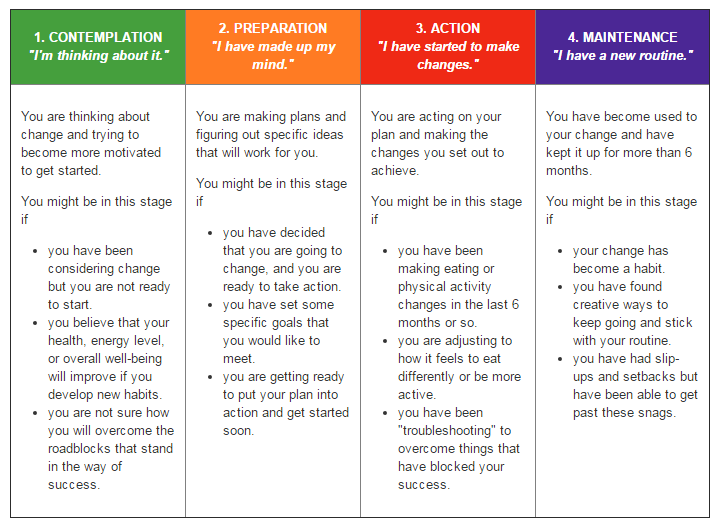 Are you thinking about a lifestyle/habit change? Have you heard of the “Stages of Change”? This is a diagram that describes what level of change you might be in or transitioning towards. The diagram below shows the four stages, where do you fit in?
Are you thinking about a lifestyle/habit change? Have you heard of the “Stages of Change”? This is a diagram that describes what level of change you might be in or transitioning towards. The diagram below shows the four stages, where do you fit in?

Are you thinking about changes to become healthier? (Contemplation)
Try making a pros and cons list about healthy food options and physical activity that apply to your current lifestyle. You can see some examples at this link to get the ball rolling and get ideas. ( Diet and Healthy Habit Changes) What if you are past thinking about change and you have been adopting healthier habits (Preparation/Action), now what?
Setting goals to help you become healthier is a great place to start or tweak any plan. (Preparation) During counseling sessions with students and clients. I help them create 3 goals each week such as a food goal, behavior goal, and exercise goal.
Creating goals should be SMART: specific, measurable, achievable, realistic and time- bound. For example, creating a food goal, saying you want to eat less fried food is an okay goal, however, it should be measurable. Only eating fried food one time a week instead of every day is a measurable, specific, and an obtainable goal. Food Goal: I will only eat fried food on Friday this week. (Action)
How about behavior changes? Goal setting helps to change habits and create better outcomes. Here are a few ideas of where to start: how about drinking more water or removing the candy on your desk, or hiding the sugary snacks that are front and center in the pantry. This saying “Out of Sight, Out of Mind” is so true. When we hide the less healthy food behind good stuff, we eat less. (Action) Swapping the candy bowl for a water jug can become a new constant fixture like the photo of your cat or beloved plant. Here is an example of how to set behavior goals. Try this measurable goal for water intake that gives you a quantity per day.
Behavior Goal: I will drink 2 (16oz) bottles of water before lunch and 2 after lunch 5 days this week. This type of goal will help those that may or may not be at a desk job. You can add more days with more water for your next goal and keep building up this goal until it becomes a new habit. (Maintenance)
Now the exercise goal. Last August, I tackled one of my goals that needed some attention. I was exercising but not on the regular, so focusing on becoming consistent and exercising 5 times a week for 1 year was my long term goal. So how does one get to long term goal status? To accomplish any lengthy task, short term weekly goals need to be achieved along the way. Exercise Goal: 5 workouts/weekly for 3 months. Then focus on being consistent until 6, 8 and 12 months. Where consistency was lacking a new habit took its place. (Maintenance)
It’s okay to start small. Maybe a realistic goal would be to exercise twice a week for 6 weeks. The New Year is upon us, a perfect time for a healthier new outlook for any level. Some places to start could be meal planning, trying healthier recipes, joining a fitness challenge and continuing on your own. Fitness buffs, make sports nutrition a focus. Pick some areas that need attention and do something about them. What stage of change are you in and what goals can help you achieve some better habits today.
Prepared by Hospitality Dietitian Mindy Diller, MS, RDN, LD mindy.diller@ttu.edu

One Comment Add yours